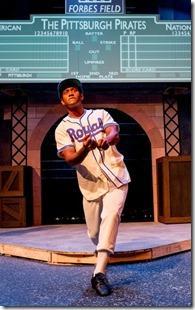
Clemente:
The Legend of 21
Written and Directed by Luis Caballero
Music by Harold Gutierrez
at Stage 773, 1225 W. Belmont (map)
thru Sept 14 | tickets: $35 | more info
Check for half-price tickets
Read review
Play about baseball great is diamond in the rough

NightBlue Performing Arts i/a/w ArtoCarpus presents
Clemente: The Legend of 21
Review by John Olson
Growing up in baseball-crazy Milwaukee during the 1960’s, players like Hank Aaron, Don Drysdale, Willie Mays and Roberto Clemente were household names (Yes, Mickey Mantle and Roger Maris were the biggest names in MLB, but they were on the Yankees, who were in the American League. The Milwaukee Braves were in the National League, thank you very much). Luis Caballero, writer and director of this play with songs (not quite a musical), lifts Clemente beyond just the image of a slugger for the Pittsburgh Pirates – one in a blur of big league hitters of that era. Clemente was a black Puerto Rican who, despite his exceptional talent on the field, experienced racial prejudice in 1950s-‘60s America along with the alienation of being a Spanish speaker in a very Anglo-centric country. He remained loyal and connected to his family and community in Puerto Rico and died in an airplane crash on his way to complete a humanitarian aid mission to Nicaragua in 1972. Jackie Robinson was the first black player in Major League Baseball when he joined the Brooklyn Dodgers in 1947, but as this story shows, it wasn’t so easy for those who followed him. Caballero’s play, with the help of his talented and immensely likeable cast connects us with the man behind the batting statistics. The play– which has been previously produced off-Broadway in New York and in Washington DC under a different title – is being produced here jointly by NightBlue and the New York company ArtoCarpus, with a cast of mostly New York based actors. Despite a number of inspired moments, though, there are problems with its narrative flow, clarity and comprehensibility that make the audience work harder than it should, keeping us from getting fully engaged in the life and era of this fascinating man.
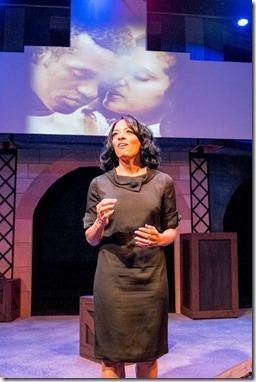
Individually, many of the scenes work like gangbusters. When Roberto arrives in Pittsburgh by way of a minor league team in Montreal, we see the difficulty Roberto (played as an adult by Modesto Lacén, the New York actor who originated the role off-Broadway) has in adjusting to life in America and the pressures of celebrity. Lacén has the look and presence of a celebrity and smoothly shows the man’s transition from innocent naïf in a strange land to a strong, but still moral figure. He does not have a great singing voice – he has trouble staying on pitch – but he has only one solo in the score of eight songs, so that’s not too much of a distraction. Roberto is shown learning to adjust to the tactics of predatory journalists and abusive/racist policemen (and could that be any more topical in this August of 2014?). There’s a particularly chilling scene toward the end of Act One in which Roberto and a friend are stopped by two white policemen, are accused of raping a young girl and forced to hold hands and pretend they’re a gay couple. The incident ends with a violent beating, but we never learn what happened after. Were they arrested, hospitalized, or worse? Again, in this August of 2014, we want to know. This question is emblematic of a certain narrative choppiness in the piece, the result of the overreliance on narration, and some odd choices on structure. There’s a love song by Vera (the beautiful and endearing Lorraine Velez) sung before we’ve even seen how she and Roberto met – an event we don’t see until after intermission, and then it’s not initially clear if the action is occurring in Pittsburgh or Puerto Rico.
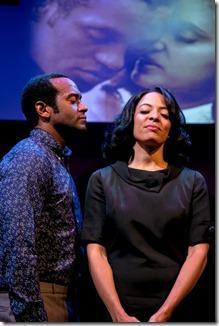
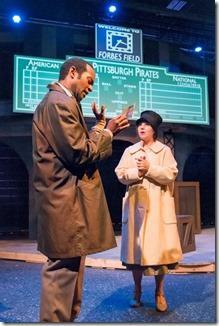
The narrative is helped greatly by projections designed by G. “Max” Maxin, combining historical footage of Clemente and the sports world with shots of Puerto Rico. Typical of the technical roughness of this production, though, is a scene in which Roberto and his father are driving down a road, with a rear projection of movement down the road behind them. Supposedly arriving at their destination, Melchor announces “we’re here,” but the road keeps receding behind them, even as the two are getting out of the car. Maxin also designed the unit set as the back wall of a stadium, including a projection screen shaped like a classic scoreboard. On it, Maxin frequently projects an image of the scoreboard at the old Forbes Field in Pittsburgh. It’s a handsome image, to be sure, but it comes off as more confusing than symbolic when it’s projected for so many scenes that don’t take place in Pittsburgh or anywhere near the park.
There are some outstanding supporting performances as well. Ricardo Puente, in a bad toupee and moustache, plays the Cuban-born sportscaster Ramiro Martinez, who befriended Clemente in America. Though Puente is a bit over the top at times, he provides moments of comedy at key points. A real find in the cast may be young John Marshall, Jr., who initially plays a sweet kid in the Puerto Rican neighborhood before taking on multiple roles as a weaselly journalist, one of the abusive cops and a haughty furniture salesman. Cast against type as these three villains, Marshall does some mighty convincing character work along with dancing and singing with the energetic ensemble.
The show is billed as a musical, though there are just eight songs – five in the first act and three in the second. The appealing music, by Harold Gutierrez, is a sprightly mix of salsa, Afro-Caribbean and Latin ballads. There doesn’t seem to be a real pattern to how music is used, though, and one wonders if the score is simply unfinished or if some songs were jettisoned and never replaced. The story and its emotions lend themselves to expression through song, and it feels like the piece could work as a full scale musical. The first act has three ensemble songs that capture the Puerto Rican setting and advance the action. In addition to the previously mentioned “The Players,” there’s “The Ticket” (accompanying young Roberto’s trip to San Juan) and “The Suitcase,” in which he flies to the U.S. Mainland to join the Montreal Royals. I would watch the first act again just to see those three numbers, and the ballads for Vera, Roberto and a duet sung by Ricardo Puenta and Giselle Vaughn are beautifully lyrical. Puenta in particular has a knockout voice and it’s too bad we don’t get to hear more of it. Ms. Vaughn shows some comic chops in a short role as Vera’s friend before switching gears to sing “You Were Like an Illusion” with Puente. Like Marshall, she’s a performer to keep our eyes on. The only complaint about the songs, apart from the feeling there aren’t enough of them, is that they’re sung entirely in Spanish without supertitles. While one gets the gist of the meaning from the situation and the songs’ titles, they lose much of the emotional punch they otherwise might have the lyrics were understood. The musical direction and new arrangements are by Aaron Benham, who unfortunately was limited to a pre-recorded band for accompaniment of the fine vocals.
That leads to the biggest question of all for Caballero, should he have hopes (and he should) for future lives of this musical. While he should clean up the narrative clarity – which seems quite fixable – and maybe make it an all-out musical (easier said than done), the first decision is to make it more accessible to English-speaking audiences. Performing most of the dialogue and lyrics in English, together with toning down the Puerto Rican accented English, would make this show an easier time for more theater goers (though granted, some of my impatience may be equally due to the failure of the Stage 773 air conditioning on that hot August night). The show and the subject matter are too good and important to not be expanded past Spanish speakers only.
Rating: ★★½
Clemente: The Legend of 21 continues through September 14th at Stage 773, 1225 W. Belmont (map), with performances Fridays at 8pm, Saturdays 4pm and 8pm, Sundays 3pm. Tickets are $35, and are available by phone (773-327-5252) or online through Vendini.com (check for half-price tickets at Goldstar.com). More information at NightBlueTheater.com. (Running time: 2 hours 20 minutes, includes an intermission)
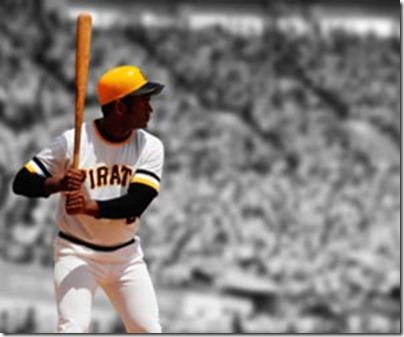
Photos by Drew Peterson
artists
cast
Modesto Lacén (Roberto Clemente as an adult), Carlos Miranda (Matino Clemente as an adult), Ricardo Puente (Ramiro Martinez, Roberto Marin, Don Oscar, Singer at Restaurant), Lorraine Velez (Vera Cristina Zabala), Willie Denton (Melchor Clemente), Whitney Rappana (Neighbor, Dorothy Carrington, Ana Maria, ensemble), Xiomara Rodriguez (Luisa Walker), Elvin Ramos (Young Matino Clemente, ensemble), Jonathan Amaro (young Roberto Clemente, ensemble), John Marshall, Jr. (Pito, Reporter, Policeman 2, Dependant, Chaperone, ensemble), Casey Hayes (Howie Haack, Policeman 1, Dr. Finegold, Sam Nover, ensemble), TJ Crawford (Gene Baker, Phil Dorsey, ensemble), Giselle Vaughn (Friend, Customer, Singer at Restaurant, ensemble)
behind the scenes
Luis Caballero (director, author, co-choreographer), Kelsey Overberg, Gigi Dichosa (co-choreographers), Luis Salgado (original choreography), Aaron Benham (musical direction and arrangements), G. “Max” Maxin” IV (set and projection design), Emma Cullimore (costume design), Jeff Wozniak (lighting design), Patrick Bley (sound design), Derik Marcussen (assistant costumer), JoAnn Robertson (makeup design), Jennifer Thusing (stage manager), Liz Tanner (stage hand), Peter O’Neill (technical director), Aaron West (assistant technical director), Chris Maves, Jim Nardulli (carpenters), David E. Walters (producer), Drew Peterson (photos)
14-0837

